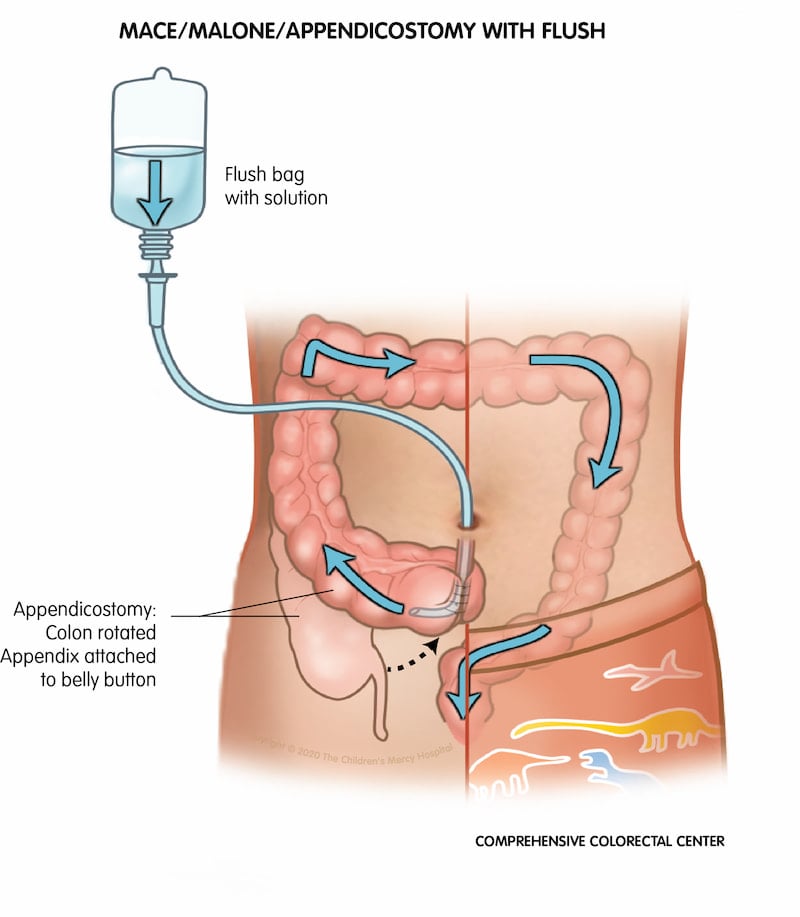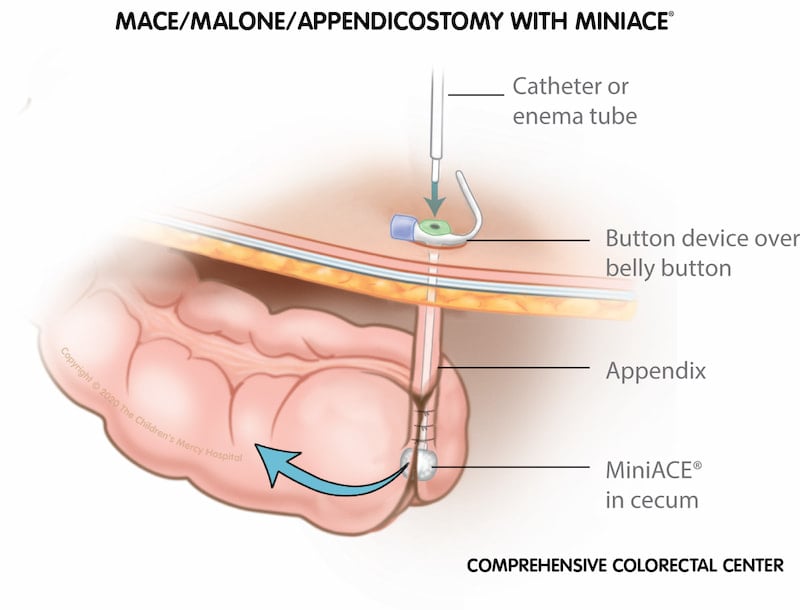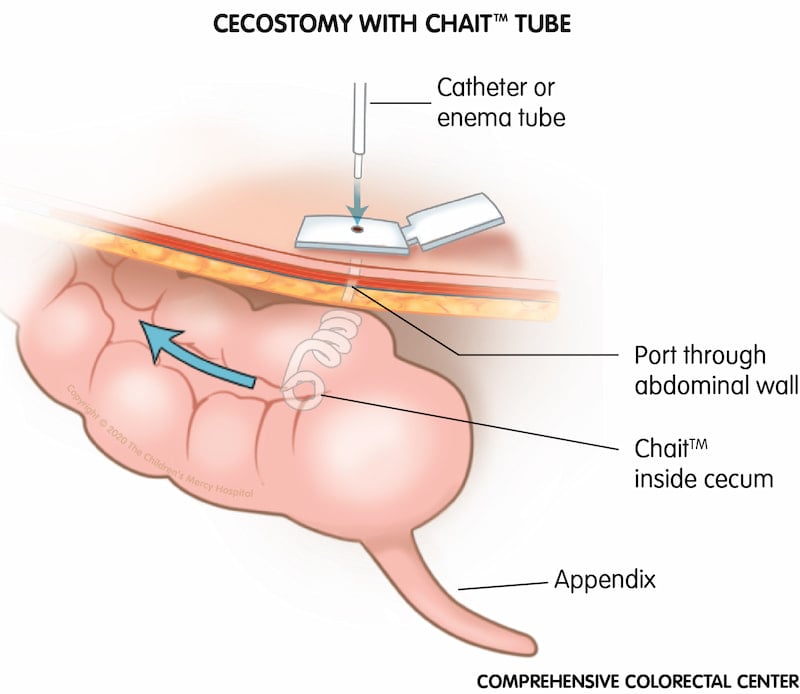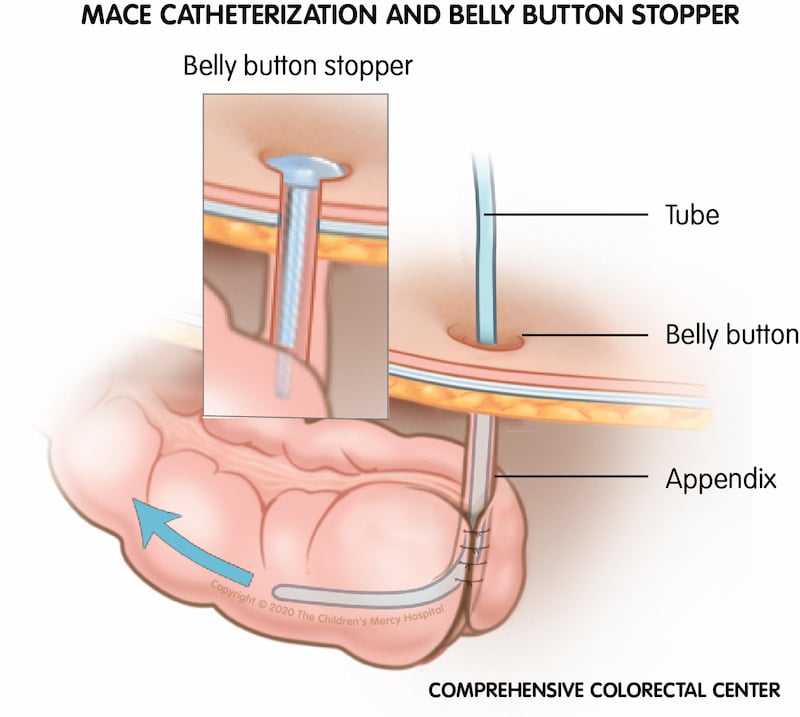Appendicostomy

An appendicostomy (ah-pen-di-KOSS-toh-me) is a surgery that is performed allowing your child to receive an enema through their belly button or abdomen.
The goal of the surgery is to make the enema process easier on everyone and work towards having a bowel movement every day, avoiding fecal incontinence (FI) and severe constipation.
During surgery to create the appendicostomy, the surgeon attaches the child’s appendix to the skin of the belly button or abdomen. This creates an outer opening to the child’s colon. The surgeon puts a tube in the new opening, which is surgically created using your child’s own tissue inside their body. This lets the enema tube or catheter get inserted for flushes, or irrigations, but no stool or body fluids can come out. The valve is hidden on the inside of the body.
An appendicostomy also is called a Malone procedure, MACE or antegrade colonic enema (ACE).
Reasons for the appendicostomy
Your child may be a candidate for surgery if they need a daily enema to prevent fecal incontinence or constipation.
Some of the conditions that cause difficulty with bowel control include:
- Anorectal malformation (imperforate anus)
- Hirschsprung disease (birth defect in which bowel nerve cells are missing)
- Spinal cord problems
- Severe functional constipation
Call for an appointment
We're here to help you. Contact us for more information about the Comprehensive Colorectal Center at Children's Mercy.
Benefits of appendicostomy surgery
The appendicostomy surgery helps with constipation and makes your child’s bowel movements planned and regular. The opening may be placed either in the belly button or on the lower right side of the belly, which makes it easy for you or your child to reach. The placement of the opening also allows your child to stay fully clothed until it is time to sit on the toilet.
Often a child will feel a greater sense of independence and control by allowing them to perform the enema (Malone flush) on their own. For older children, it helps provide privacy and lets them manage their poop schedule. Since the hole isn’t visible, unless performing an enema, no one except your child, family and surgeon will know it exists.
The procedure still allows your child to play and participate in most activities, including swimming.
How is the appendicostomy performed?
- Typically, this is a laparoscopic procedure, a minimally invasive surgical technique. During the surgery, your surgeon will make a small cut in the abdominal wall (skin of the belly). Then, using the appendix, (a finger-like tube attached to the colon), the surgeon connects the colon to the outside of the body, creating an opening.
- Next, a small one-way valve is surgically created, using your child’s body tissue. This one-way valve is hidden inside your child’s body and is how the enema tube or catheter gets inserted for flushes (irrigations). It will allow enema fluid to go in, but no poop or liquid will leak out.
- Once the valve is created, a temporary tube is placed to make sure the opening stays clear while the newly created valve heals. This tube allows your child to perform enemas and will be removed after the skin heals.
What is the difference between appendicostomy and cecostomy?

Appendicostomy: The appendix is used to attach the colon to the abdomen or belly button to make an outer opening. This lets the enema tube or catheter get inserted for flushes, or irrigations, but no stool or body fluids can come out. The valve is hidden on the inside of the body. An appendicostomy also is called a Malone procedure, MACE or antegrade colonic enema (ACE).
Neo-appendicostomy: A neo-appendicostomy (KNEE-oh-ah-pend-ih-KOSS-toh-me) may be performed if your child has had their appendix removed. A piece of colon tissue will be used to create a tube in place of the appendix.

Cecostomy: With this surgery, the appendix is not used. A small soft plastic tube, called a cecostomy tube or port, is inserted directly from the abdomen into the colon (specifically, the cecum, the colon entry point). This creates an immediate opening to allow the colon to be cleaned out (flushed). Where the tube comes out of the body, it is level with the skin, with a button device.
For both an appendicostomy and a cecostomy: Liquid laxatives are given by placing a catheter (a thin tube) into the opening of the appendicostomy or into the cecostomy tube through a connection tube or large syringe. A Chait™ or MiniACE® device can be placed into both so that you do not need to find the hole.
Preparing for surgery
You will receive specific instructions for your child prior to surgery. Typically, they will not be able to eat or drink anything after midnight. It may also be necessary to give medicine the day before the surgery to clean poop out of the colon. The surgeon may ask this be done at home or in the hospital.
Day of surgery
The day of the surgery, you will bring your child to the hospital at a designated time, usually a few hours before surgery time.
After checking in at Same Day Surgery, a nurse will escort you to an exam room. Here, you will meet with Child Life, your surgeon and a pediatric anesthesiologist before surgery. The team will review the surgery and answer any questions you may have. Surgery takes about 1 hour. Throughout this time, the registration staff will provide updates on your child.
Once your child’s surgery is complete, you will have the opportunity to meet and talk with your surgeon. After your child is stable and awake from anesthesia, you will be reunited, and a team member will take you to your room.
After surgery care
After the appendicostomy, your child will likely stay in the hospital for a few days. This is to make sure your child is recovering well and gives you time to learn your child’s flush routine.
We encourage getting out of bed and walking around soon after the surgery. Once your child starts passing gas and stool, he or she can start drinking. When your child is drinking well, his or her diet will be advanced to regular solid food. Then, once your child is eating regular food, he or she will get their first enema in the hospital through the new tube.
Before going home, the team will teach you how to care for the appendicostomy and how to give an enema through the tube. Some children will need flushes once a day and others may need them twice a day. Always call the Comprehensive Colorectal Center with any questions.
How to care for your child’s opening and tube
- To keep the newly created hole open and prevent the body’s natural reaction to try and close it, it’s important to put the enema tube through the appendicostomy hole at least once a day. This should be done even if your child isn’t receiving enemas.
- Some leaking around the tube is normal. However, it is helpful to keep the area around the external enema tube clean and dry.
- Tape may be used to keep the external tube in place on the belly.
Level of activity at home after surgery
Once you return home, your child can start slowly adding normal activities into their day. It’s best to avoid vigorous activity and contact sports (and you can always call us with any questions about activities). Your surgeon will evaluate your child and provide guidance on appropriate and approved activities at the one-month follow up appointment.
Common questions
What if I can’t put the tube in the appendicostomy?
First, get a washcloth and run it under warm water. Then place it on the opening for a few minutes to help relax the opening, allowing the tube to fit in. If after trying the warm washcloth you still can’t put the tube in the appendicostomy, call the Comprehensive Colorectal Center at Children’s Mercy. It is possible there is a stricture (the hole is getting smaller).
What is the pink or red bumpy tissue around the appendicostomy?
It is called granulation tissue and occurs when new tissue forms, signaling a wound is healing. It is normal and harmless to your child and can be treated with various home treatments after discussing with your surgeon.
When should I replace my child’s tube?
The tube that is inserted during surgery will stay in place for the first month. During the one-month office visit, the tube may be removed. The team will teach you and your child how to place an ACE stopper in the opening. The stopper is made of silicone and keeps the skin from closing.
Some children have a Chait™ tube or MiniACE® placed into the appendicostomy opening instead, which stay in place and then get replaced every three months.
How do I place the ACE stopper?

Follow these steps when placing the ACE stopper:
- Clean and dry your child’s skin with soap and warm water.
- Put the water-based lubricant on the end of the ACE stopper so it will go in easier.
- Gently insert the stopper until the disc of the stopper is flat against your child’s belly.
- You can keep the stopper in place by putting a Band-Aid® or tape over the top.
- Change the dressing every day to keep the site clean and free from irritation.
- Call the Comprehensive Colorectal Center if your child’s skin gets irritated or if you are not able to insert the ACE stopper.
- Colorectal Center
- Speak With Our Team
- Comprehensive Colorectal Care
- Conditions and Treatments
- Bowel Management Boot Camp
- Colorectal Surgery
- Resources for Caring for Colorectal Conditions at Home
- Insurance Information
- Advancing Care Through Research
- What to Expect
- Meet the Team
- General and Thoracic Surgery


